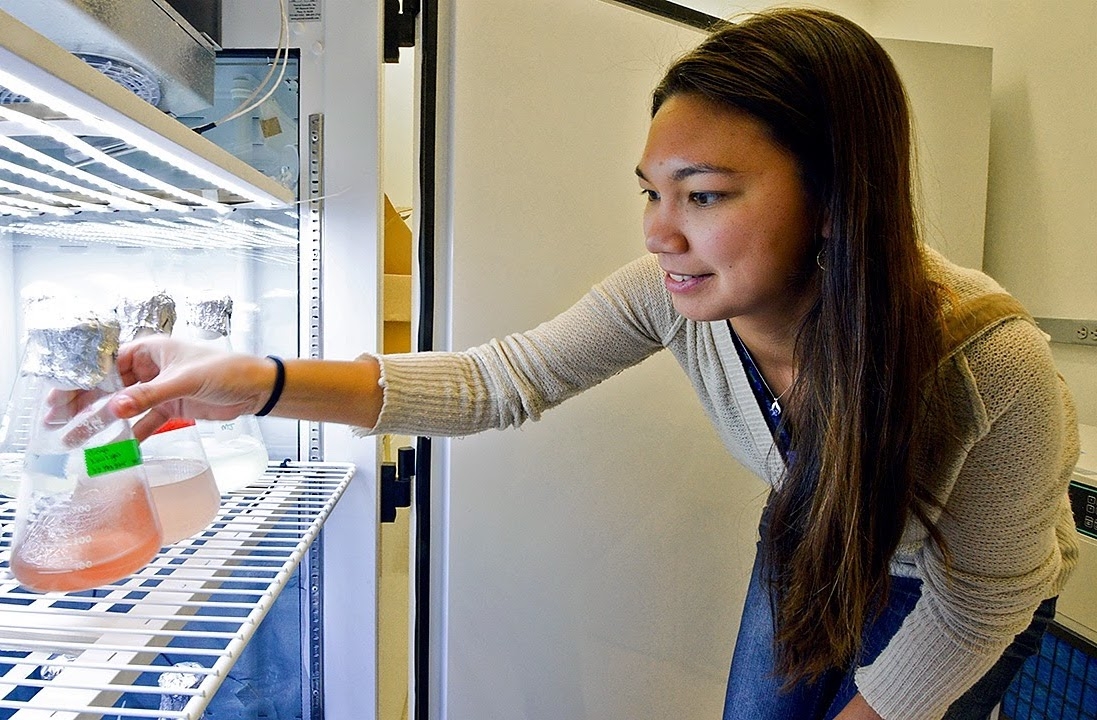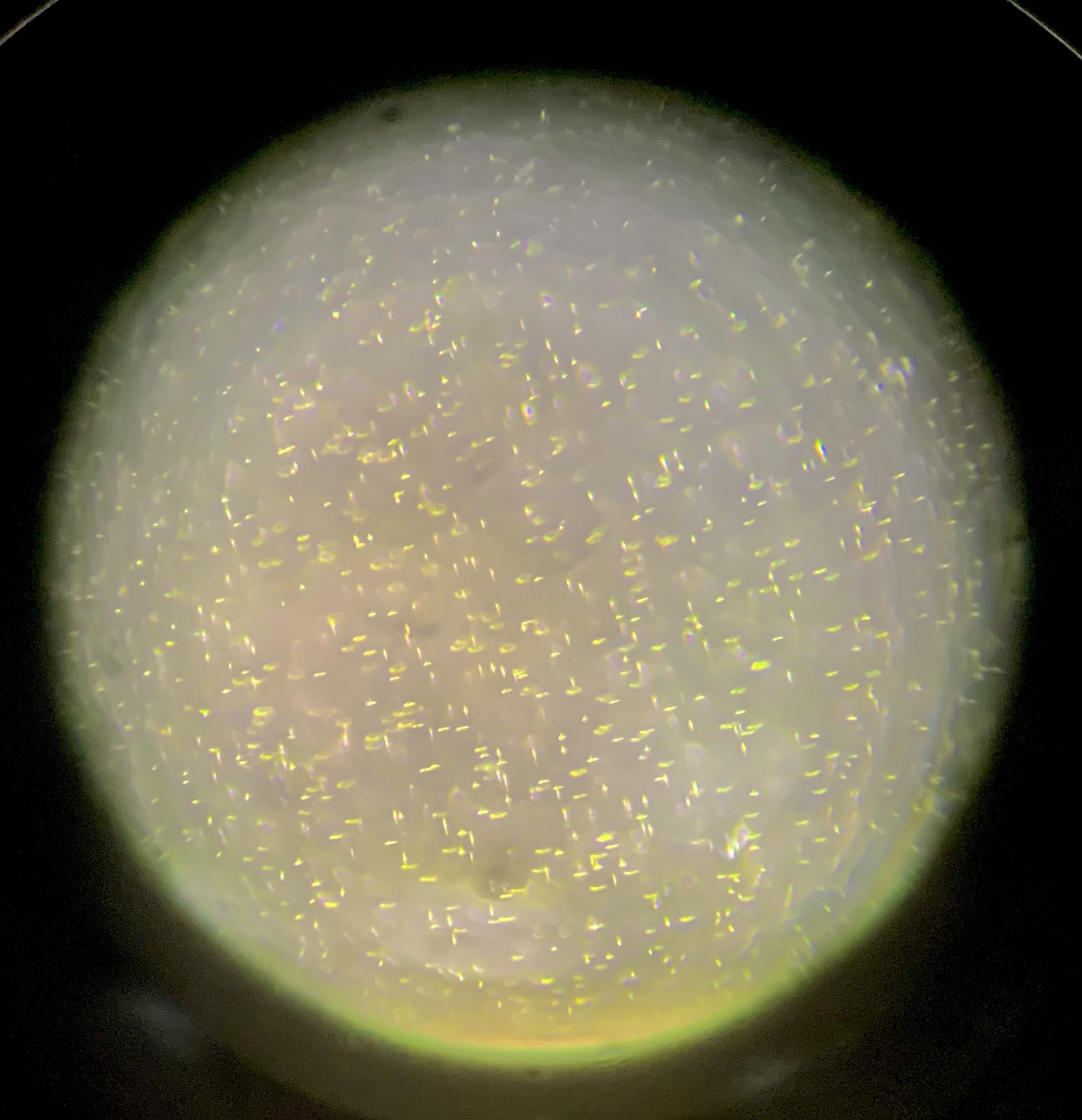
Biologist Holly Moeller investigates the role of mixotrophs, organisms that can both eat and photosynthesize
In biology, there are organisms that produce their own food and those that must obtain it elsewhere. This distinction between autotrophs and heterotrophs is a familiar aspect of the natural world for most people.
Then there are mixotrophs. “They combine both forms of metabolism, functioning as both plant and animal simultaneously,” explained Holly Moeller, an assistant professor in the Department of Ecology, Evolution, and Marine Biology at UC Santa Barbara. “These are nanoplankton, so even with a decent microscope they mostly look like swimming sparkly dots!”
The National Science Foundation (NSF) has conferred Moeller with a CAREER award to study how these metabolically flexible organisms function and how they are impacted by environmental change. This five-year grant will enable her to expand her lab, which specifically focuses on mixotrophic plankton, to carry out more experiments and to create educational outreach opportunities for undergraduate students and K-12 teachers.
It’s one of two new accolades for Moeller, whose lab has carved out a niche working on these quirky but important ocean organisms. She has also been elected an Early Career Fellow of the Ecological Society of America (ESA), a distinction that recognizes ESA members who have advanced ecological knowledge and applications and show promise of continuing to make outstanding contributions to the range of fields served by the organization.
“When you work on mixotrophs you have all the challenges of a major photosynthesizer and a major grazer,” Moeller said. “There have been — and continue to be — some really steep learning curves as we work out the methodology to handle that.”
The miniscule mixotrophs the lab studies are omnipresent in the surface of Earth's oceans and lakes, although scientists are just beginning to appreciate their role since it's hard to identify and keep track of what they're doing. “Some reports suggest that mixotrophs could be the dominant photosynthesizers or grazers in the surface ocean, depending on the time of year,” Moeller said, “and they are expected to become more important as climate change increases the ocean's stratification.”

There's an increasing sense of urgency to develop ways to predict how ecosystems will respond to human activity. Evolution can add an extra layer of complexity to this task, especially for microbial communities, where short generation times mean evolution can take place within just a few months.
Moeller’s lab has shown that mixotroph evolution can be particularly complicated because it can create a positive feedback loop. “And I don't mean positive like ‘it's a good thing,’” Moeller said, “but rather ‘self-reinforcing.’”
It works like this. The warmer the mixotroph gets, the more it relies on eating food rather than photosynthesizing its own food. When mixotrophs eat, they produce carbon dioxide. “The more carbon dioxide in the atmosphere, the warmer the planet gets, the more mixotrophs eat and so on,” Moeller said. When the team ran their first evolution experiments, they found that evolution could exacerbate this effect. Mixotrophs that had the chance to evolve at hotter temperatures ate even more than ones that hadn't.
Moeller and her team believe they can learn how to predict a mixotroph's evolutionary response by looking at its current biology. Namely, mixotrophs with a lot of metabolic flexibility probably won't evolve as much as those with more constrained life processes. The thinking is that there’s no reason to change at the genetic level if you can just change your behavior and gene expression.
Funding from the CAREER award will enable Moeller and her team to test this hypothesis with metabolic assays and evolution experiments. They plan to pair these with mathematical models to extend their understanding beyond their experimental results. The five-year grant will also support a laboratory technician, two postdoctoral researchers, a dozen undergraduate researchers, and the equipment and supplies they will need to carry out the project.
Moeller wasted no time before sharing credit with her team. “The weird thing about the NSF CAREER award is that it's presented to just one individual, the principal investigator,” she said. “But the fact that it has only my name on it is a misnomer. In reality, the ideas from this grant emerged from years of work on mixotrophs by our team.”
She commended undergraduate researcher Gina Barbaglia for completing a deep dive into the phenotypic plasticity of mixotrophs. Meanwhile, conversations with postdocs Suzana Leles, Kevin Archibald and Ferdinand Pfab provided Moeller with a new perspective on Barbaglia’s data, including ways to model it. Finally, Moeller credited the lab’s success to two former trainees, Michelle Lepori-Bui and Logan Gonzalez, whose two papers on the response of mixotrophs to climate change came out late last year.
The grant provides almost $40,000 for outreach, which will support efforts to expand math literacy. This includes a seminar course for incoming students who are enrolled in calculus. Moeller aims to bridge mathematical concepts to biological ones and create learning support structures in the classroom. Additionally, she has partnered with Charlotte Zeamer, head of school and teacher services at the Santa Barbara Museum of Natural History, to create an outreach curriculum and K–12 teacher trainings.
“I really believe that our society would be full of people who love math if they saw it through a slightly different lens during their schooling,” Moeller said. “In my ecological modeling course, a lot of students come in expressing some math anxiety.”
Instead of asking her class to jump right into solving equations, Moeller submits questions to their biological intuition. For example, how might a population of elephants change over time? “It's really easy for the class to come up with a bunch of different ideas about what the elephants are doing that we can diagram on the chalkboard together,” she said. “Well guess what? That's a mathematical model!
“And when you see how the equations describe a process that you understand intuitively? Well, I've seen this magical moment of clarity for some of my students.”
Harrison Tasoff
Science Writer
(805) 893-7220
harrisontasoff@ucsb.edu



